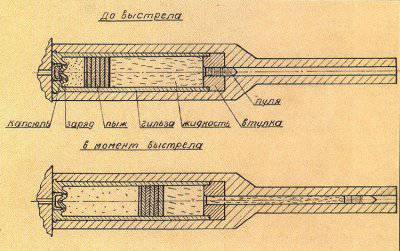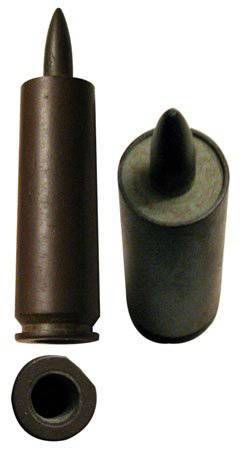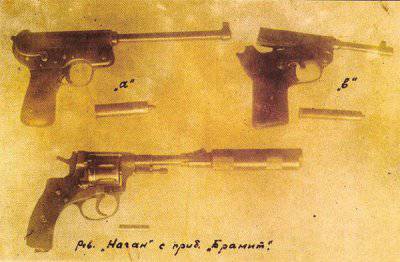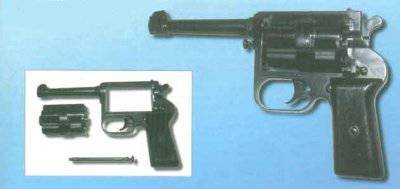Domestic silent weapons. Silent cartridge Gurevich and weapons for him
 As is clear from the above, Gurevich developed not just a weapon, but a complex consisting of two cartridges of different caliber, but identical in principle of operation, as well as a weapon for them: a pistol (it didn’t survive, it’s only known that it was single-shot) and a revolver. Let's try to sort out the ammunition in more detail, since it is they that are the basis of “noiselessness” in this case, and then with the weapon, since it was far from all that possible to shoot with such cartridges.
As is clear from the above, Gurevich developed not just a weapon, but a complex consisting of two cartridges of different caliber, but identical in principle of operation, as well as a weapon for them: a pistol (it didn’t survive, it’s only known that it was single-shot) and a revolver. Let's try to sort out the ammunition in more detail, since it is they that are the basis of “noiselessness” in this case, and then with the weapon, since it was far from all that possible to shoot with such cartridges.Gurevich developed two ammunition caliber 6,5 millimeters and caliber 5,6 millimeter. In both cases, the cartridges were completely identical designs with locking of powder gases in the sleeve. However, there was in them the same feature that made them unique, namely that a bullet was pushed by a liquid. The most ordinary water became a kind of pusher that was placed inside the cartridge and pushed the bullet out of the barrel as the powder gases expanded. To understand what these munitions are, it suffices to consider the procedure for equipping cartridges. So, a powder sample was placed in a sleeve with an already installed capsule. After the powder was closed with a wad, which was a steel circle on both sides, supplemented with cardboard gaskets, which, after installation, were paraffin-filled to prevent water from penetrating to a powder charge. Next, distilled water was poured into the sleeve and a sleeve was inserted, which was sealed along the edge of the sleeve, and a bullet of much smaller diameter compared to the sleeve was placed in the hole along its center. Thus, when fired, the powder charge ignited and the powder gases, expanding, pushed the wad-piston. In turn, the wad played the role of a piston that squeezed water out of the sleeve, and since the bullet inserted into the brass cushion was the weakest point, it flew out with decent acceleration and followed by water. Naturally, such an ammunition is “death to the weapon,” even though the water was distilled. But it would be quite possible to put up with this, since such a weapon is quite specific and no one would have broken from more careful care of it. It was much worse that the water pushing the bullet significantly reduced the speed of the wad-piston, as it had to flow from the larger diameter of the liner to the smaller diameter of the hole in the sleeve in which the bullet was installed. In addition, there were such negative moments as the sleeve breaks at the sleeve, as well as the loss of the sleeve. However, a lot depended on the quality of manufacturing the cartridge, so the idea itself was quite viable.
 The disadvantages of these munitions can not be attributed to the fact that water at low temperatures usually freezes, which leads to the inevitable rupture of the cartridge shells, although this could be solved by adding the same salts to the water, but then the storage period of such munitions would be short-lived and the weapon would clearly not have benefited. Nevertheless, in 1943, various types of silent weapons were tested, in which Gurevich's cartridges took part, along with a pistol for them, a revolver appeared a little later. In fact, Gurevich's weapons and cartridges competed in these trials with Nagan, equipped with a Brahmit (MITINA BRANCH) noiseless firing device, and the 5,6 caliber version even beat Nagan with PBS on accuracy. However, despite the fact that the ammunition showed greater accuracy, they could not compete with the Nagnoye equipped with PBS BraMit, due to the more complex design of cartridges, which in turn required special weapons, and even had obvious problems with storage. For cartridges caliber 6,5 millimeters, the following data is available. The real diameter of the bullet is 6,76 millimeters, with a length of 16 millimeters. The mass of the bullet is equal to 5,1 grams, with the mass of the cartridge itself in 58 grams and the mass of the powder charge 0,4 grams. The length of the cartridge was 74,7 millimeter, the diameter of the flange 17,5 millimeters. An 5,6 millimeter cartridge had a bullet with a real diameter of 5,78 millimeters, with a length of 14 millimeters. The bullet weight was 3,5 grams, the cartridge itself had a weight of 41 grams, and the powder charge had a mass of just 0,15 grams. The length of the cartridge is 83,3 millimeters, the diameter of the rim is 13,3 millimeters. Bullet velocities for both versions of the cartridges are approximately the same: 222-230 meters per second for a cartridge with a caliber 6,5 of millimeters and 214-222 meters per second for a cartridge with a caliber of 5,6. As is clear from all of the above, the cartridges for hunting ammunition 20 and 32 caliber served as the basis for the cartridges, so it can be said that the cartridges were relatively cheap, but naturally not cheaper than the cartridge to Nagan with a reduced weight of gunpowder.
The disadvantages of these munitions can not be attributed to the fact that water at low temperatures usually freezes, which leads to the inevitable rupture of the cartridge shells, although this could be solved by adding the same salts to the water, but then the storage period of such munitions would be short-lived and the weapon would clearly not have benefited. Nevertheless, in 1943, various types of silent weapons were tested, in which Gurevich's cartridges took part, along with a pistol for them, a revolver appeared a little later. In fact, Gurevich's weapons and cartridges competed in these trials with Nagan, equipped with a Brahmit (MITINA BRANCH) noiseless firing device, and the 5,6 caliber version even beat Nagan with PBS on accuracy. However, despite the fact that the ammunition showed greater accuracy, they could not compete with the Nagnoye equipped with PBS BraMit, due to the more complex design of cartridges, which in turn required special weapons, and even had obvious problems with storage. For cartridges caliber 6,5 millimeters, the following data is available. The real diameter of the bullet is 6,76 millimeters, with a length of 16 millimeters. The mass of the bullet is equal to 5,1 grams, with the mass of the cartridge itself in 58 grams and the mass of the powder charge 0,4 grams. The length of the cartridge was 74,7 millimeter, the diameter of the flange 17,5 millimeters. An 5,6 millimeter cartridge had a bullet with a real diameter of 5,78 millimeters, with a length of 14 millimeters. The bullet weight was 3,5 grams, the cartridge itself had a weight of 41 grams, and the powder charge had a mass of just 0,15 grams. The length of the cartridge is 83,3 millimeters, the diameter of the rim is 13,3 millimeters. Bullet velocities for both versions of the cartridges are approximately the same: 222-230 meters per second for a cartridge with a caliber 6,5 of millimeters and 214-222 meters per second for a cartridge with a caliber of 5,6. As is clear from all of the above, the cartridges for hunting ammunition 20 and 32 caliber served as the basis for the cartridges, so it can be said that the cartridges were relatively cheap, but naturally not cheaper than the cartridge to Nagan with a reduced weight of gunpowder. As already noted above, only Gurevich's pistol was present at the tests, which was a single-shot sample, in which the barrel bore opened during “flapping”, like smooth-bore guns, therefore it is not surprising that even despite the ruptures of the sleeves, this sample showed yourself as the quietest of all the subjects. However, problems with removing the liner, as well as its singly charged, could not give him a ticket to mass production. It is for this reason that the designer continued to refine his revolver, despite the fact that the weapon and cartridge were rejected. In parallel with the revision of the revolver, Gurevich also experimented with various calibers of his ammunition, however, the initially selected 5,6 caliber of millimeter was the most successful. So Gurevich still finished his revolver, which still did not get spread, but this does not mean that the weapon was bad.
 In principle, it’s useless to talk about the revolver itself, since the main essence of noiselessness was precisely in the cartridges, but in view of the possible problems with removing the liner and other things, the revolver was at that time an ideal design, if not for one "but." And "but" it was that without obvious advantages, these weapons would have to be made from scratch, while Nagant was a fairly common weapon that easily adapted to using the Bramite silent firing device. In addition, silent Nagant ammunition was much cheaper to manufacture, although it differed from the original design of the bullet, but about them in another article. It cannot be said that Gurevich's revolver or pistol was a weapon more acceptable than the same Nagant with BraMit, but the designer achieved his main goal, namely, he made his weapon very quiet, but the fact that using such a sample was not the most convenient , although the impossibility of using a weapon at a negative temperature seriously limits its capabilities, but even here it could be somehow perverted if desired.
In principle, it’s useless to talk about the revolver itself, since the main essence of noiselessness was precisely in the cartridges, but in view of the possible problems with removing the liner and other things, the revolver was at that time an ideal design, if not for one "but." And "but" it was that without obvious advantages, these weapons would have to be made from scratch, while Nagant was a fairly common weapon that easily adapted to using the Bramite silent firing device. In addition, silent Nagant ammunition was much cheaper to manufacture, although it differed from the original design of the bullet, but about them in another article. It cannot be said that Gurevich's revolver or pistol was a weapon more acceptable than the same Nagant with BraMit, but the designer achieved his main goal, namely, he made his weapon very quiet, but the fact that using such a sample was not the most convenient , although the impossibility of using a weapon at a negative temperature seriously limits its capabilities, but even here it could be somehow perverted if desired. If practically nothing is known about Gurevich's pistol, then with a revolver there are some scraps of information. So the weapon was a five-shot, had a double-action firing mechanism. In addition, the axis of the revolver's drum could be twisted, which made it possible to relatively quickly replace the drum with a new curb if the first inflated sleeves were stuck in the chambers. By the way, this problem was not resolved by Gurevich without worsening the characteristics of ammunition. The revolver itself was rather large and had the appearance of not quite slim and elegant, looking at it, it creates the feeling that the weapon is too cluttered, a very big contrast between the revolver itself and its handle. This appearance of the weapon is due to the fact that the revolver was fed not with the smallest ammunition in size, which determined the size of the drum of the weapon, and hence the whole revolver as a whole.
If practically nothing is known about Gurevich's pistol, then with a revolver there are some scraps of information. So the weapon was a five-shot, had a double-action firing mechanism. In addition, the axis of the revolver's drum could be twisted, which made it possible to relatively quickly replace the drum with a new curb if the first inflated sleeves were stuck in the chambers. By the way, this problem was not resolved by Gurevich without worsening the characteristics of ammunition. The revolver itself was rather large and had the appearance of not quite slim and elegant, looking at it, it creates the feeling that the weapon is too cluttered, a very big contrast between the revolver itself and its handle. This appearance of the weapon is due to the fact that the revolver was fed not with the smallest ammunition in size, which determined the size of the drum of the weapon, and hence the whole revolver as a whole.If we talk about the work of Gurevich on the scale of the development of silent firearms, it should be noted that of the Soviet designers it was he who first decided to lock the powder gases in the sleeve, which was the beginning of the development of a whole series of ammunition with the same principle. But naturally, nobody used water as a bullet pusher, limiting itself to more rigid structures, which allowed such ammunition to successfully develop to those that can be found in modern models of weapons. But if we talk about the design of Gurevich cartridges, then, in my opinion, these are the most interesting ammunition from all that were invented in the first half of the twentieth century. However, this is still not all, but other silent samples of weapons and ammunition will be discussed in other articles.
- Karasik Kirill
- guns.ru
Information